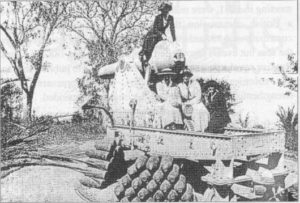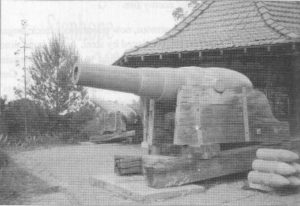- Author
- Davies, Jim
- Subjects
- 19th century wars, History - pre-Federation
- Tags
-
- RAN Ships
- None noted.
- Publication
- March 1999 edition of the Naval Historical Review (all rights reserved)

The old naval guns in Kings Park are of interest for a couple of reasons. They are early products of an arms race which lasted until 1942 and their arrival in Western Australia came about because of the reactions of the Australian colonies to a perceived threat from a foreign power.
First the arms race which began ten years before the Kings Park guns were made.
Until the Crimean War of 1853-1856 the Royal Navy had for centuries ruled the seas with wooden sailing ships firing broadsides from muzzle-loading smooth-bore cannon. During the first half of the 19th Century auxiliary steam power had slowly become common as had the use of exploding spherical cannon balls (“shells” or “bomb-shells”). Change came very slowly.
In 1855 the new Armstrong cannon came on the scene. It was a breech-loader (the ammunition was fed in from the rear of the gun) and like the now standard small arms it had a rifled barrel. Spiral grooves cut into the bore of the barrel make the gun more accurate by making the projectile spin on its axis instead of tumbling about as it sped through the air. The new gun seemed ideal for firing shells accurately at long range at enemy ships and it was adopted as the Royal Navy standard weapon in 1859.
Unfortunately for the Royal Navy, by 1863 a new heavy smooth-bore muzzle-loader had to be rushed into service as a temporary replacement for the Armstrong gun and the search was on for a new gun. What had gone wrong?
In 1859 the French had launched LA GLOIRE, a wooden ship with a steam engine and, more importantly, with iron plates protecting its sides – an “ironclad”. More were to follow. Britain re-acted to this threat of loss of control of the seas by starting a programme which saw 79 coastal forts under construction within eight years and by immediately building her own superior ironclad, WARRIOR (now preserved near VICTORY in Portsmouth). However Britain’s own tests had shown that shots from the Armstrong breech-loader could not penetrate the new armour. Furthermore all did not go well with the Armstrong guns when in 1863 RN ships shelled the Japanese port of Kagoshima tc avenge the death of an Englishman there, many guns jamming or misfiring. Back to square one.

Meanwhile in the American Civil War of 1861-65 both sides quickly developed ironclads and the Union navy even built a series of all-iron steamships with guns in fixed turrets, the Monitor class. Both sides found the only sure way to destroy an ironclad was to ram it – just like the tactics of the Greek and Roman galleys of old. Shot from guns even as big as 15″ usually shattered or bounced off.
The solution was to combine the strength and simplicity o1 the muzzle-loader with the accuracy and superior projectile of the rifled gun, as had been done for some years with small arms. The result was the RML – the rifled muzzle-loader. Trials in 1863 between RML designs by Whitworth and Armstrong showed the latter to be superior but later trials in 1864-5 led to the adoption of the Woolwich Arsenal design (very similar to Armstrong’s). The size of the gun was set at 7 inches (177.8mm) – i.e. the diameter of the bore of the barrel. Bigger guns followed in the course of time.
The Kings Park guns, one of which carries the date 1866, are of this design. The barrel was built up by shrinking successive strengthening hoops of metal (usually of wrought iron) on to the main barrel tube (usually steel). Three grooves spiralled down the bore of the barrel. The shot, which could be solid or a hollow shel filled with gunpowder, had three sets of two or three studs dowr the side to engage the rifling grooves.




